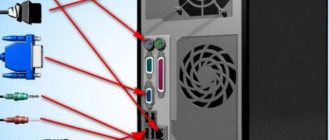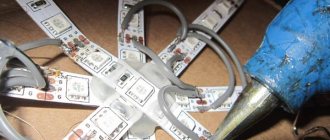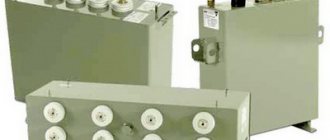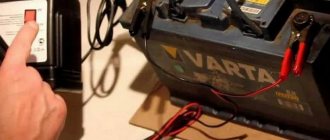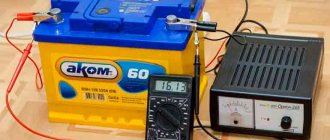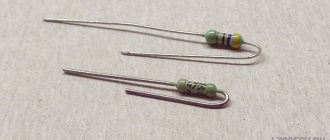Wireless charging is convenient: you throw the gadget on the stand and don’t need to connect anything. How cool it would be to use them to recharge electric cars!
And why are these strange scientists still unable to reproduce the technology of the great Tesla? They are strange, they have been working for a hundred years and there is no result.
This is exactly what almost everyone who thinks about modern electricity transmission technologies thinks. After all, without wires it’s faster, more convenient and more reliable (probably).
In practice, the transmission of small currents without wires is easily feasible over short distances. But as soon as high current, increased operating power or a long transmission distance are required, serious problems associated with the simplest physical laws begin.
And there are other intractable problems.
Nikola Tesla - a great teacher and a great deceiver
Most of the myths associated with the wireless transmission of electricity came to humanity from conspiracy theorists and the numerous myths they “digested” about the great Serbian-American inventor.
At the beginning of the twentieth century, through experiments in Colorado Springs, he demonstrated the possibility of transmitting an electromagnetic field at a distance, when he managed to light a light bulb at a distance of over three kilometers.
How did he do it? There is no official answer to this question, since the experimental methodology remained secret. But the famous records tell a completely different story.
But there are laws of physics and eyewitness impressions that speak of the incredible power of the transmitter (by the standards of time, of course): much more energy was spent than any light bulb needed.
And since there are no numbers, no data - isn’t this a myth, like many of his other developments? Tesla turned out to be the greatest hoaxer of his time, and modern “achievements” allow us to reveal this in all its glory.
Today they are trying to repeat his work with the help of investments from the New Zealand energy company Powerco by the local startup Emrod.
According to official information, the Emrod project provides for wireless energy transfer between the receiver and transmitter at a line-of-sight distance, which, in fact, can be tens of kilometers.
The created prototype is currently undergoing laboratory tests, and then field tests will begin, in which it is planned to transmit current with a power of up to 2 kW.
It is stated that due to new radio-absorbing materials, the efficiency of the receiving (rectifying) antenna has been increased to 100%, and the efficiency of the transmitting system is approaching 70%.
And then they got caught: nothing can have 100% efficiency . The laws of conservation of energy and the principle of causality have not been canceled: the transmitted wave cannot be completely converted into the required type of energy.
In the case of electricity and real engineering devices, everything is completely sad.
Transfer principles
Power generation
The latest developments by scientists from the USA and South Korea used magnetic resonance systems CMRS and DCRS. Korean technology turned out to be more advanced. It was possible to transmit electricity over 5 meters. Thanks to compact DCRS dipole coils, it is possible to power all consumers in a medium-sized room without wires.
Important! The imperfection of modern equipment significantly limits the length of the path of electricity through the air.
Despite this, scientists around the world are busy developing new technologies whose task is to transfer energy over distances of tens and hundreds of kilometers. Already today, new scientific achievements in the field of electricity delivery without wired power lines are being developed and implemented.
Wireless charging has low efficiency
Today, there are three main power options for Qi wireless charging: 5 W, 7.5 W, 10 W. For comparison, the most common wired ones are 5 W, 10 W and 18 W.
The efficiency of wired power supplies that convert alternating current into direct current with specified parameters balances in the range from 50 to 85%. The rest is released by heat and is expressed by heating the elements of the electrical circuit.
The minimum condition for Qi to work with at least 5 W is a 10 W charger. Otherwise, nothing will work, charging will not work.
At the same time, to operate Qi with a power of 10 W, you need a power supply with support for QC 3.0 at 18 W or more powerful (it is often suggested to use a PD at 24 W).
The conversion efficiency is only 55%.
The transmission itself from the charger to the device is also a source of loss: the phone on average receives 4.2 W out of 5W (85% efficiency) and 9.1W out of 10W (about 90% efficiency).
From 18 W, make 9.1 W with an efficiency of 50% - is this now called “green, economical energy”?
Are there really no better technologies? Eat. Theoretically, the problem is simple: increase the voltage, reduce the current, reduce losses.
Only in electronics the battery is 4.35 V , so you will have to equip your smartphone with a step-down converter. Which must be calculated
- for specific charging parameters
- with voltage reserve
- and have large losses due to the conversion and the characteristics of the transistors used for it
High-power wireless interfaces actively promoted by Xiaomi and other Chinese brands offer higher currents.
Due to this, as well as expensive electronics (and a specific distribution of costs), they manage to achieve an efficiency of up to 55-70%.
However, they require high-power Power Delivery current sources with a power of 65 W and above, which themselves have quite high losses.
Therefore, most often manufacturers complete Qi-charging with its own power supply. As a result, the total cost of an accessory on the free market can reach 20-40% of the cost of the gadget itself. There is nothing to buy separately. So why, if most likely with a new smartphone you will have to buy a more powerful device?
To the origins of the appearance
In 1893, an exhibition was held in Chicago. There was a demonstration of wireless lighting, in which everything was powered by fluorescent lamps. This work belonged to Nikola Tesla.
Now you can repeat the experiment - just stand with a fluorescent lamp under a high voltage line. And then it was more like a session of magic, which is why the inventor gained such popularity.
Today, not every scientist will agree that it was Tesla who came up with the idea of creating wireless electricity. They believe that his work is a refinement of an existing idea. For example, 73 years before the exhibition, Andre Ampere wrote down a law that indicates that when an electric current is used, a magnetic field is created. Eleven years later, Michael Faraday discovered the law of induction. An experiment was conducted that showed that a magnetic field generated in one conductor induces a current in the other conductor.
In 1864, all theories were united. The work belongs to James Maxwell. He came to an equation that described the electromagnetic field, as well as the connection with electric charges and currents in a vacuum.
Twenty-seven years later, Tesla modernized the wave transmitter that Hertz had invented a little earlier. He patented it as a device for radio frequency power supply.
No one has canceled heat losses
The second problem is the thermal losses already mentioned above: the energy that is lost in the process of converting electric current from alternating to direct and when transmitting it over a distance is converted into heat.
Heating occurs. Mainly the charger itself, and due to this, the gadgets being charged.
For a conventional LiPo battery, losses even during normal charging are at least 15-20%. Add higher losses, typical for wireless transmission, and we get a lot of heat.
All this needs to be directed somewhere and dispersed in space: LiPo batteries are very afraid of any heat - often 100 degrees is enough for a small fire.
Another problem lies in the wireless charging device. What is this? A set of electromagnetic coils with a pair of chips that transmit the field to the same coils to the charging gadget.
Poor positioning and different coil sizes increase losses and heat, reducing charging speed.
Sometimes they try to solve this with magnets ( MagSafe ), sometimes with moving coils or increasing their number, sometimes by simply turning off the process when heating. The results are not bad, but only for low currents.
We increase the transmission power - we get a multiple increase in losses. In fact, even 65 W without precise positioning can be considered a small fire.
Is it worth the risk or leave the technology in prototype form until people get used to using wireless chargers?
Power coupling
This part is necessary when one device cannot transmit energy to another device.
Magnetic coupling is generated when an object's magnetic field is capable of inducing an electric current to other devices within its range.
Two devices are said to be mutually inductively coupled or magnetically coupled when they are arranged so that a change in current as one wire induces a voltage at the ends of the other wire by means of electromagnetic induction. This is due to mutual inductance
Wireless electricity interacts with metal
In fact, existing chargers are a little more complicated than just a set of coils: there are several more levels of protection at the protocol level (yes, the charger and the gadget communicate with each other) and circuit design.
One of the levels blocks charging from turning on when a metal object hits the electromagnetic transmitter.
Once above the transmitting induction coil, the metal will inevitably begin to heat up. For example, a few minutes will be enough for the same paper clip to become hot and begin to melt the plastic.
In MagSafe and car holders, the magnets and their corresponding metal parts lie away from the coil, so there is no interaction.
In more complex systems, very precise positioning must first be established. This is unlikely for a car, drone or electrical outlet.
Theoretically, it is possible to select a transmission frequency at which the interaction will be minimal (cunning coils will be required).
A prototype of the solution exists and has been tested for many years. But it has not yet reached series production, and this is unlikely to happen in the foreseeable future: the cost is high, the complexity of manufacturing and work is increased.
On top of that, the charging process is more unstable.
The harm of electromagnetic radiation has not been proven. And will not be refuted
This is the most interesting question, to which there is a specific answer only with certain devices and boundaries. Of course, Qi-chargers for gadgets are completely safe.
Even the most powerful copies available for retail purchase are operational only at a short distance: the radiation power should not exceed 50 mW/cm2 at a distance of 20 cm from charging.
True, there is a subtlety: the distance and power on it are limited by the rules of the Communications Commissions (different countries). Since assumptions about possible harm exist, but have not been clearly established.
The radiation practically does not penetrate further due to its properties: the electromagnetic radiation of the coil with current propagates in a ring shape, forming a closed circuit.
Directional radiation requires other frequencies, other powers, and other types of radiation. The harm of which, by the way, has been studied a little more.
Low-power radio transmitting devices, in particular mobile phones, do not affect the human body: experiments show the absence of a negative effect on the human body.
Exposure to high-power stations, such as radars and base stations, at certain frequencies is harmful in the immediate vicinity of the source and can cause illness. Otherwise there is no confirmed information.
What happens if you significantly increase the power of Qi-like charging? Obviously, everything depends on the specific parameters of the current: strength, voltage and frequency.
It is possible to select them correctly, but due to human stupidity you can always end up with an emergency situation.
But the “Tesla current transmission method”, favored by geeks, perfectly knocks out machines and spoils equipment: frequency resonance is inevitable.
However, even here you just need to choose the right parameters to eliminate interaction. And hope that equipment that does not meet the new standard will not end up between the charger and the device being charged.
II. Electricity production and use
Electricity generation
Electricity generation is the production of electricity by converting it from other types of energy using special technical devices. To generate electricity, use: Electric generator - an electrical machine in which mechanical work is converted into electrical energy. A solar battery or photocell is an electronic device that converts the energy of electromagnetic radiation, mainly in the light range, into electrical energy. Chemical current sources are the conversion of part of chemical energy into electrical energy through a chemical reaction. Radioisotope sources of electricity are devices that use the energy released during radioactive decay to heat a coolant or convert it into electricity. Electricity is generated at power plants: thermal, hydraulic, nuclear, solar, geothermal, wind and others. Almost all power plants of industrial importance use the following scheme: the energy of the primary energy carrier, using a special device, is first converted into mechanical energy of rotational motion, which is transferred to a special electrical machine - a generator, where electric current is generated. The main three types of power plants: thermal power plants, hydroelectric power plants, nuclear power plants. Thermal power plants (TPPs) play a leading role in the electric power industry of many countries. Thermal power plants require huge amounts of organic fuel, but its reserves are decreasing, and the cost is constantly increasing due to increasingly complex production conditions and transportation distances. Their fuel utilization rate is quite low (no more than 40%), and the volume of waste that pollutes the environment is large. Economic, technical, economic and environmental factors do not allow thermal power plants to be considered a promising way to generate electricity. Hydroelectric power plants (HPP) are the most economical. Their efficiency reaches 93%, and the cost of one kWh is 5 times cheaper than other methods of generating electricity. They use an inexhaustible source of energy, are serviced by a minimum number of workers, and are well regulated. In terms of the size and power of individual hydroelectric power stations and units, our country occupies a leading position in the world. But the pace of development is hampered by significant costs and construction time due to the remoteness of hydroelectric power station construction sites from large cities, lack of roads, difficult construction conditions, subject to the influence of seasonality of river regimes, large areas of valuable riverine lands are flooded by reservoirs, large reservoirs negatively impact the environmental situation, powerful hydroelectric power stations can only be built in places where appropriate resources are available. Nuclear power plants (NPPs) operate on the same principle as thermal power plants, i.e., the thermal energy of steam is converted into mechanical energy of rotation of the turbine shaft, which drives the generator, where mechanical energy is converted into electrical energy. The main advantage of nuclear power plants is the small amount of fuel used (1 kg of enriched uranium replaces 2.5 thousand tons of coal), as a result of which nuclear power plants can be built in any energy-deficient areas. In addition, the reserves of uranium on Earth exceed the reserves of traditional mineral fuel, and during trouble-free operation of nuclear power plants they have little impact on the environment. The main disadvantage of nuclear power plants is the possibility of accidents with catastrophic consequences, the prevention of which requires serious safety measures. In addition, nuclear power plants are poorly regulated (it takes several weeks to completely shut them down or start them up), and technologies for processing radioactive waste have not been developed. Nuclear energy has grown into one of the leading sectors of the national economy and continues to develop rapidly, ensuring safety and environmental cleanliness.
1.1 Generator
An electric generator is a device in which non-electrical types of energy (mechanical, chemical, thermal) are converted into electrical energy. The principle of operation of the generator is based on the phenomenon of electromagnetic induction, when an EMF is induced in a conductor moving in a magnetic field and crossing its magnetic lines of force. Therefore, such a conductor can be considered by us as a source of electrical energy. The method of obtaining induced EMF, in which the conductor moves in a magnetic field, moving up or down, is very inconvenient for practical use. Therefore, generators use not linear, but rotational movement of the conductor. The main parts of any generator are: a system of magnets or, most often, electromagnets that create a magnetic field, and a system of conductors that cross this magnetic field. An alternator is an electrical machine that converts mechanical energy into alternating current electrical energy. Most alternators use a rotating magnetic field.
| Alternating current generators, as well as direct current generators, are based on the use of the phenomenon of electromagnetic induction. The DC generator commutator in the AC generator is replaced by slip rings. In the simplest alternating current generator, the conductors, made in the form of a frame, are connected at their ends to slip rings. The rings rotate with the frame; brushes slide along their surface, connecting the generator to the external circuit. In AC electrical machines, the rotating part is called the rotor and the stationary part is called the stator. | A permanent magnet rotates in a rectangular circuit |
When the frame rotates, the magnetic flux through it changes, so an emf is induced in it. Since the frame is connected to an external electrical circuit using a current collector (rings and brushes), an electric current arises in the frame and the external circuit. With uniform rotation of the frame, the angle of rotation changes according to the law:
The magnetic flux through the frame also changes over time, its dependence is determined by the function:
where S is the area of the frame. According to Faraday's law of electromagnetic induction, the induced emf arising in the frame is equal to:
where is the amplitude of the induced emf. Another quantity that characterizes the generator is the current strength, expressed by the formula:
where i is the current strength at any time, Im is the amplitude of the current strength (the maximum absolute value of the current strength), φc is the phase shift between fluctuations in current and voltage. The electrical voltage at the generator terminals changes according to a sinusoidal or cosine law:
or
Almost all generators installed in our power plants are three-phase current generators. Essentially, each such generator is a connection in one electric machine of three alternating current generators, designed in such a way that the emfs induced in them are shifted relative to each other by one third of the period:
Electricity usage
Power supply for industrial enterprises. Industrial enterprises consume 30-70% of the electricity generated as part of the electrical power system. The significant variation in industrial consumption is determined by the industrial development and climatic conditions of different countries. Power supply for electrified transport. Rectifier substations of electric transport on direct current (urban, industrial, intercity) and step-down substations of intercity electric transport on alternating current are powered by electricity from the electrical networks of the EPS. Electricity supply for municipal and household consumers. This group of buildings includes a wide range of buildings located in residential areas of cities and towns. These are residential buildings, administrative buildings, educational and scientific institutions, shops, healthcare buildings, cultural buildings, public catering, etc.
The more current sources, the less predictable the consequences
Finally, there is another unsolved physical problem: the superposition of electromagnetic fields. The more chargers and their power, the further and further their waves travel.
At some point they will begin to interact. This doesn't seem like a problem at first glance.
Exactly until someone decides to place a couple of charges next to each other, shifting the propagation vector to something sensitive to the electromagnetic field.
This “something” could be a communications device, a pacemaker, a communications station, or any other electronic device.
The problem is not that it will be affected by one source - theoretically, even powerful wireless chargers can be designed so as not to interfere with electronics.
But when waves superimpose on each other, an unknown value will be obtained that is difficult to predict. Is this risk necessary?
By the way, judging by rumors, this is what “killed” the AirPower wireless charging from Apple, which could carry 32 coils (low-current!).
“Over time, these harmonics add up and very powerful signals appear in the air,” he explains. “And this can be difficult - for example, such radiation could stop someone’s pacemaker if it was powerful enough. Or short-circuit someone’s hearing aid.”
William Lumpkins, Technical Vice President, O&S Services
If your Apple device was causing harmonics to fly out in all directions, your AirPower may have failed US or EU regulatory tests.
Technology
Principle of inductive coupling
Two devices mutually inductively coupled or magnetically coupled are designed so that the change in current when one wire induces a voltage at the ends of the other wire is produced by electromagnetic induction. This is due to mutual inductance. Inductive coupling is preferred due to its ability to operate wirelessly as well as its resistance to shock.
Resonant inductive coupling is a combination of inductive coupling and resonance. Using the concept of resonance, you can make two objects work depending on each other's signals.
Inductive coupling resonance concept
As can be seen from the diagram above, resonance is provided by the inductance of the coil. The capacitor is connected in parallel to the winding. Energy will move back and forth between the magnetic field surrounding the coil and the electric field around the capacitor. Here, radiation losses will be minimal.
There is also the concept of wireless ionized communication.
It can also be implemented, but it requires a little more effort. This technique already exists in nature, but it is hardly feasible to implement it, since it requires a high magnetic field, from 2.11 M/m [10]. It was developed by the brilliant scientist Richard Walras, the developer of a vortex generator that sends and transmits heat energy over vast distances, in particular with the help of special collectors. The simplest example of such a connection is lightning.
Each device needs its own charger
The same problem with the positioning of electromagnetic coils ultimately leads to the next one - the lack of a uniform standard in the industry.
The companies agreed to use low-current Qi technology and unified the devices. But either Samsung or Xiaomi release models that do not work with other people’s chargers at full speed.
Xiaomi's high-power wireless charging, introduced a couple of months ago, only works when it hits the base exactly.
And it quickly charges the battery only up to 50%, subsequently reducing the power from 80 to 20 W. Moreover, even at maximum “speed” the efficiency is only 65 W.
This charger does not work “at low speed” with other smartphones - the coils are of a different size. For the same reason, standard Qi-chargers “swing” with the corresponding Mi 11 Ultra only up to 10 W.
A single process standard is needed, otherwise the infrastructure will only work for one manufacturer.
Even with smartphones, this is not beneficial to the user. And what about cars?
Especially when existing prototypes from Momentum Dynamic promise incredible, impossible 100% efficiency?
We will have to modernize the world's energy supply
Finally, there is one more reason that only opponents of electric vehicles like to mention. The existing world is already entangled with wires of a certain cross-section, developed electrical networks and equipped power plants.
Any sharp increase in electricity consumption requires serious modernization.
In Russian new buildings in industrial cities this is almost unnoticeable. But imagine: in London there are still houses with “plugs”, powered by thin lines that were centuries old. Entire streets have been preserved, powered with the personal participation of Westinghouse at the beginning of the last century.
And here it is proposed not only to use electricity everywhere, but to do it with low efficiency and huge heat losses.
Most cities are not ready for this. Because wireless charging still needs to be powered by something - and this line will have to be made VERY thick, increasing energy production.
That is, 50% more wind turbines, solar panels, or another thermal power plant will be required, since they do not scale well.
